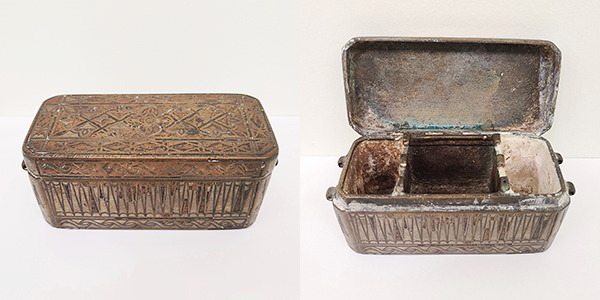Philippine Betel Nut Box

For people in South and Southeast Asia and Oceania, chewing betel nut is a tradition dating back thousands of years. What is referred to as betel nut is actually a piece of nut from the areca palm dabbed with slaked lime and wrapped in a betel leaf. Sometimes other ingredients like tobacco or spices are added to the wrap, which is known as a quid. Chewing it provides a mild stimulant effect. Betel nut is used by an estimated 600 million people, making it one of the most popular mind-altering substances in the world, alongside nicotine, alcohol, and caffeine. Frequent users can often be identified by their red or purple stained teeth.
Chewing betel nut can have many cultural meanings, and it was once central to ceremonial occasions and social interactions. Reflecting its importance, ornate metal boxes like this one were made to hold the ingredients. They were often put out to welcome guests or even carried by the owners on straps when they went out. The boxes also served as a sign of prestige, with higher status individuals having boxes made of silver or gold with elaborate designs.
This betel nut box from the island of Mindanao in the Philippines is cast bronze with inlaid designs. Although it was collected in the mid-20th century, it is likely older than that. It was made by the Islamic Maranao people, who are well known for their metalsmithing, especially inlay work. The decoration includes traditional Muslim okir designs, a distinct flowing motif also found in Maranao woodcarvings and textiles. The box has three interior compartments for the individual betel nut ingredients. The slaked lime left the white residue you can see in the right section. The box originally had small hinged lids for each compartment that are now missing.
Learn about another artifact from the Philippines with this Artifact of the Month post about a Bontoc Axe.
